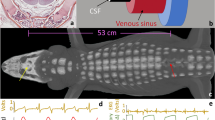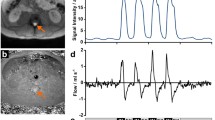Abstract:
Since vascular pulsation in the cerebrospinal fluid causes the cerebrospinal fluid pulse wave (CSFPW), spinal CSFPW may serve as a monitor of spinal cord blood flow. However, there are two possible sources of spinal CSFPW: brain and spinal cord pulsation, and it is unclear for which region spinal CSFPW provides blood flow information. To resolve this question, we analyzed changes in CSFPW caused by occlusion of the large vessels in mongrel dogs. The thoracic and abdominal aorta (TA group, n = 13; AA, n = 6), bilateral internal carotid arteries (ICA, n = 7), and superior and inferior vena cava (SVC, n = 6; IVC, n = 8) were occluded. The CSFPW was measured at the second cervical and sixth lumbar spine level. To eliminate the influence of hemodynamic changes caused by the occlusion, CSFPWs were decomposed into component frequencies, harmonic waves (HWs), and analyzed using the system analysis method. After occlusion, cervical CSFPW was decreased in groups ICA (change in the first HW, 38%; P < 0.05 by Wilcoxon signed-ranks test), TA (40%; P < 0.05), and SVC (53%; P < 0.05), while lumbar CSFPW was decreased in groups TA (71%; P < 0.01), AA (78%; P < 0.05), and IVC (48%; P < 0.05). These results show that spinal CSFPW provides information on the blood flow of a relatively localized region, and could be used to monitor spinal cord blood flow.
Similar content being viewed by others
Author information
Authors and Affiliations
Additional information
Received for publication on May 28, 1997; accepted on Aug. 11, 1997
About this article
Cite this article
Nakamura, K., Urayama, K. & Hoshino, Y. Site of origin of spinal cerebrospinal fluid pulse wave. J Orthop Sci 3, 60–66 (1998). https://doi.org/10.1007/s007760050022
Issue Date:
DOI: https://doi.org/10.1007/s007760050022




